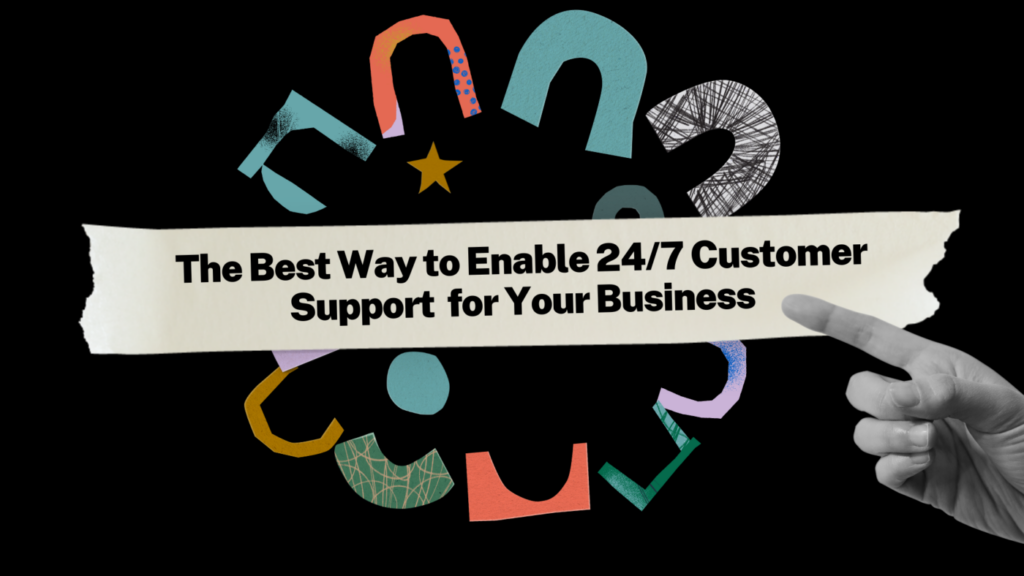7 minutes
Providing exceptional customer service is crucial for any business looking to succeed in today’s highly competitive market. However, limiting your support availability to just regular business hours means losing out on connecting with customers during the remaining 167 hours of the week. Implementing 24/7 customer support coverage is a must for companies that aim to stand out from the crowd and gain an edge over the competition.
But enabling round-the-clock assistance can seem daunting, especially for smaller businesses with limited resources. The good news is that with careful planning, strategic use of technology, and some outside assistance, establishing 24/7 customer support is easier than you think.
This article will explore practical strategies and solutions to help you extend your customer service availability and provide seamless 24/7 support coverage. From leveraging automated tools to outsourcing support tasks, we’ll discuss various approaches to setting up and managing an around-the-clock help desk.
Unique Challenges of Providing 24/7 Customer Support
Transitioning from limited-hour customer service to always-on support comes with some unique challenges. Here are some key difficulties businesses face when trying to enable seamless, round-the-clock assistance:
Increased Staffing Requirements
Covering 24 hours a day, 7 days a week, means you need enough support staff to handle inquiries at all times. For smaller teams of 5-10 agents, this often requires doubling or even tripling your staff size to maintain adequate coverage when operating in multiple shifts.
Also, hiring more full-time agents represents a significant increase in overhead costs. As an alternative, some businesses opt to staff up using part-time or on-call workers to fill gaps in coverage. However, relying on temporary or contract workers can result in inconsistent service quality.
Managing Customer Support Across Time Zones
When customers are located across different time zones worldwide, you need to carefully coordinate shift hand-offs to avoid any gaps in support coverage. For example, as your East Coast team in New York winds down for the evening, your West Coast team in San Francisco needs to seamlessly pick up incoming requests without delays.
Getting this time zone orchestration right requires tracking each region’s call and ticket volumes and staffing appropriately. One mistake can lead to customers being left hanging with no one available to assist, which causes frustration.
Potential for Agent Burnout
Working evening, overnight, and weekend shifts to provide 24/7 assistance can take a toll on agents over time. Disrupting circadian rhythms by frequently alternating sleep schedules often leads to fatigue and burnout.
Even for teams that specialize in overnight support, the long hours and unnatural schedules can be challenging to sustain in the long term. Agents start to experience diminished energy levels, lack of focus, irritability, and higher absenteeism. This can degrade the quality of service they are able to provide customers in the midst of burnout.
Consistency in Service Quality
With multiple shifts and teams handling customer requests, maintaining a consistently high level of service 24/7 becomes difficult. For example, late-night and early-morning teams may not be equipped to handle more complex issues, while other teams may have knowledge gaps on certain products or services.
Without proper oversight and training, service quality and average resolution times can vary wildly between shifts. Customers who notice these inconsistencies in their experience, depending on when they call in, will quickly get frustrated.
Dealing with System Downtime
To enable 24/7 customer service capabilities, your core support tools, software systems, and IT infrastructure also need to be highly stable and reliable around the clock. Network outages or software problems overnight or during weekends can completely cripple a help desk operation when demand is still high.
Not having full team availability to troubleshoot tech issues or provide status updates during non-peak hours can further prolong system failures. Businesses need robust redundancy across all critical platforms to minimize the impact of downtime on 24/7 support delivery.
Despite these hurdles, with the right solutions and strategies, businesses can overcome the challenges and reap the rewards of providing 24/7 customer support.
Leveraging Technology for 24/7 Customer Support
The key to effectively managing an around-the-clock help desk is leveraging the right technologies to enhance and streamline support operations. Here are some of the top tools and platforms enabling 24/7 assistance:
Help Desk Software
All-in-one help desk platforms like Zendesk and Freshdesk optimize workflows by automatically assigning, routing, escalating, and tracking support tickets. Robust features like skill-based routing and SLA tracking help manage high ticket volumes from a global customer base.
Chatbots and Virtual Assistants
Chatbots allow customers to get instant answers to common questions at any time of day or night. Virtual assistants like Intercom and Drift can initiate conversations and handle simple requests, freeing up agents for more complex issues.
Knowledge Management Systems
A searchable knowledge base with FAQs and support documentation empowers customers to self-serve for quick answers. It also gives agents access to resources to solve or escalate inquiries faster.
CRM Integration
By connecting your help desk software with your CRM, support agents get access to each customer’s full history and account details for more personalized service. Salesforce, Zoho, and other CRMs help create seamless hand-offs between support and sales.
Social Media Management
Monitoring social channels like Twitter and Facebook lets you respond to comments and messages, provide assistance, and manage crises in real time – 24/7. Tools like Sprout Social and Sendible help manage global social engagement.
Omnichannel Support
Offering support across multiple channels – phone, email, live chat, messaging apps, etc. – allows customers to get help over their preferred medium at any hour. Solutions like Zendesk, Freshdesk, and Intercom enable seamless omnichannel experiences.
Outsourcing for 24/7 Customer Support
For many businesses, outsourcing customer support to an external partner is an effective way to enable 24/7 coverage while controlling costs. Here are some advantages of outsourcing your help desk:
Access to Trained Agents
Outsourcing providers staff their operations with highly-trained, skilled agents to handle customer support requests. This instantly provides your business with expanded capabilities.
Built-in Redundancy and Scalability
Large outsourcing teams offer built-in redundancy to handle support spikes. They can also easily scale up or down as your business grows.
Time Zone Expertise
Global outsourcers have expertise in managing support across time zones. They can implement seamless hand-offs to keep operations running 24/7.
Latest Support Technologies
Outsourcers invest heavily in support platforms and infrastructure. By partnering with one, you instantly gain access to enterprise-level technology.
Cost-Effective Support
Outsourced support costs a fraction of building an in-house 24/7 help desk. You get economies of scale and pay only for the support hours you need.
When evaluating outsourcing partners, look for a provider with robust IT support expertise, global service capabilities, flexibility to scale as per your needs, and advanced support tools and technologies. Partners like Scale Support, SupportLogic, TaskUs, and Conduent can enable your business to implement affordable 24/7 customer support.
Training and Empowering Your Team
If you choose to run your 24/7 help desk in-house, then robust training and empowerment of your support team is essential for success. Here are some best practices:
Implement Comprehensive Onboarding
New support hires need rigorous multi-week onboarding covering your products, services, systems, and compliance policies. Equip them to handle inquiries accurately starting day one.
Conduct Ongoing Product and Process Training
Regularly train agents on new product releases, features, and internal tools and systems updates to keep their knowledge sharp. Conduct refresher courses on support processes and practices.
Institute Shift Handoff Procedures
Create structured shift handoff protocols for support tiers to brief each other when handing over ongoing client issues and open requests.
Empower Agents to Make Decisions
Give frontline agents autonomy to make judgment calls to resolve customer issues. Empowered agents can provide better service without constant escalations.
Enable Access to Knowledge Resources
Ensure agents have access to comprehensive knowledge bases, FAQs, forums, and internal experts to find answers quickly without putting customers on long holds.
By continually training and enabling your support staff, you can drive consistency and excellence across all shifts to deliver 24/7 support with high quality and speed.
Implementing a Follow-the-Sun Support Model
To provide truly seamless 24/7 customer service coverage across the globe, leading multinational businesses use a follow-the-sun support model. This involves strategically distributing support teams across different time zones to maximize continuity.
Here is how a sample follow-the-sun setup works:
- The Latin America team provides Tier 1 support from 8 am to 5 pm for their regional customers. At the end of their shift, they hand off any open requests or ongoing cases to the North American team in a shared ticket management system.
- The North American team based in New York then continues working on these open tickets from noon to 9 pm at their local time. This ensures no break in assisting Latin American customers even after the local support day ends.
- Once the North America shift winds down, the EMEA team in London picks up where they left off and works open tickets from 4 pm to midnight their local time.
- Finally, at the end of the EMEA shift, the APAC team in Singapore or Australia takes the baton and provides coverage from 8 am to 5 pm until the cycle repeats.
This synchronized approach ensures customers have support agents available to assist at any time of the day or night, regardless of time zone differences.
Key advantages of a follow-the-sun support model:
- Customers get assistance 24/7 without interruption or handoff delays
- Critical issues that require time can be worked on continuously by multiple regions
- Agents are fresh and energetic during normal daytime hours in their region
- Helps prevent agent fatigue and burnout from overnight shifts
- Support leaders have a global view of operations
Optimizing a follow-the-sun model requires streamlining handovers, implementing request-tracking procedures, and monitoring workload levels across regions. But, the effort pays dividends in the form of happy customers with support accessible around the clock globally. With strategic planning, you, too, can distribute your best support resources into multiple time zone regions to deliver seamless 24/7 assistance.
Monitoring and Measuring Success
To refine your 24/7 support operations for optimal efficiency, you need to monitor, measure, and analyze key performance metrics continuously. Important KPIs to track include:
Average First Response Time
How fast, on average, are you responding to new support tickets? Benchmark and try to lower this hourly, daily, and weekly.
Average Resolution Time
The time taken on average to resolve customer tickets. Optimizing this end-to-end can improve customer satisfaction.
Customer Satisfaction (CSAT) Scores
Customer feedback surveys allow you to measure their overall satisfaction with the support experience. This helps identify issues and training gaps.
Net Promoter Score
Would your customer recommend your business to others based on their support experience? The NPS indicates loyalty and satisfaction.
Resolution Rate
The percentage of support tickets that get resolved without reopening or escalating to higher tiers. Aim for the highest resolution rates.
Level 1 Resolution Rate
How many tickets get resolved at the initial support level without transfers or escalations? Higher L1 resolution rates minimize delays.
Tools like Zendesk, Freshdesk, and Intercom help capture all these KPIs and more in easy-to-analyze reports. Study them to optimize processes, staffing levels, skills training, and technologies for peak 24/7 customer support operations.
24/7 Customer Support is Within Reach
Always-on support is an attainable goal for any business committed to delivering top-notch customer experiences. What’s more, implementing 24/7 assistance leads to substantial benefits like higher satisfaction, sales, and loyalty. However, it’s not without its challenges; finding the right staff, keeping them from burning out, and ensuring consistent performance can be tough, but can be overcome with the right approaches.
Ensure round-the-clock support by leveraging technologies like AI and omnichannel software to optimize operations. You should also look into outsourcing; managed service providers give you access to experienced agents and robust infrastructure for affordable coverage. When you have the team you need, training and empowering them crucial for driving excellence across shifts.
While transitioning to round-the-clock support requires investment and effort, the impact on customer retention and lifetime value makes it well worth it. Set a goal to implement 24/7 assistance within the next quarter. Start by auditing your current capabilities and benchmarking competitors. Build a business case showing the ROI of always-on service. With the right solutions mix for your needs, seamless 24/7 support coverage is within reach.
Aya is Scale Support’s blog manager. When she’s not wrangling content briefs, editing article drafts and handling on-page SEO, she is crafting messages for Scale’s other communication materials. Aya writes about SaaS startups, marketing for startups, search engine optimization, and pop culture.






